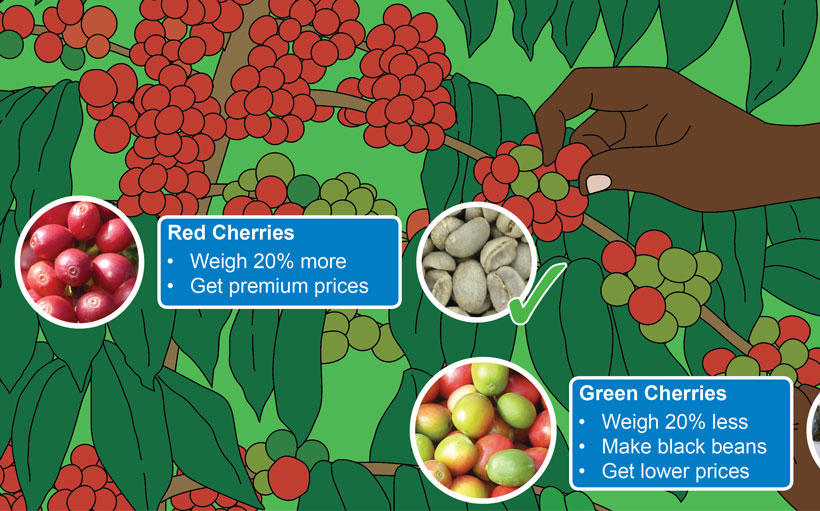- A Short History of Ugandan Coffee
- The Future of Coffee in Uganda
- Better Arabica Coffee
- Better Robusta Coffee
1.7 million subsistence farmers raise coffee on mixed plots with food crops like beans and bananas. But until recently, Ugandan coffee fetched low prices in the global market, and production was falling. How did coffee became Uganda’s most important cash crop, and how can we get better quality coffee and much bigger harvests?
A Short History of Ugandan Coffee
While it’s well known that Arabica coffee originates in Ethiopia, Robusta is said to come from Uganda, along the shores of Lake Victoria. Today, Uganda is the biggest exporter of coffee in the Commonwealth, the second biggest in Africa, and the fourth biggest exporter of Robusta coffee in the world.
Ugandan coffee is popularly known as Kiboko coffee. Before independence, colonial officials would move through the fields maintaining the crop, and whipping farmers who resisted. The word “kiboko” means “hippo”: colonial whips were made from hippos’ tails.
Amazingly, “kiboko” practice continued after independence, under Obote and Amin.
Coffee prices have fluctuated wildly over the last 50 years, bringing down some governments and buoying others along the way. Climbing prices in the 1970s provided a lifeline to Amin, but ever since the sector has been hit by successive crises: the collapse of the cooperatives and global coffee agreements in the 1980s, and the dramatic rise and fall in international prices in the 1990s.

Coffee production took off in Vietnam in the 1990s, depressing the Robusta price depressed, while Coffee Wilt Disease wiped out nearly half of the country’s Robusta trees in the early 2000s.
But the enormous growth of Starbucks transformed coffee culture, increasing demand and the market for speciality Arabica coffees. The 4x increase in prices from 2001 – 2011 created a new opportunity for Ugandan farmers, and an incentive for farmers to revive their coffee fields, and their incomes.
The Future of Ugandan Coffee
Scientists say that coffee yields are a third or even a quarter of what they could be with better pruning, and the application of herbicide and pesticide. The challenge is how to communicate good agricultural practices to farmers effectively.
For example, the single most effective practice is to “stump” or prune back to the base old overgrown coffee trees. Studies show that over 5 years, stumping and fertiliser use, leads to a 3 fold increase in yields.
The problem is that a stumped tree produces zero coffee in the first year, and for a farmer whose gets his cash income from coffee, the payoff is not worth it.
The solution is a compromise between the agronomist’s ideal practice, and the farmer’s realism: stump 20% of your trees each year.
Overgrown, tired trees are just one of the problems farmers face, together with depleting soils; smaller farms as the population has grown; increasing erosion; more pests and diseases; and increasing climate change. Projections indicate that Uganda will be 2-4oC warmer by 2100 than it was in 2000; it will also be wetter.
Together with Kyagalanyi, the biggest coffee exporter in Uganda, we developed a curriculum covering each of these challenges to improve coffee farming, boosting yields and increasing prices.
In each example, we looked for a compromise between scientific ideals and everyday pragmatism, communicating in a simple and aspirational way. The final posters were made as a calendar, both to remind farmers of what practices they should do each month, and to be stuck up in the house as a decoration and reference for years to come. The clear line illustrations were created by Okudi Deogratius and Sam Rich.
Better Arabica Coffee
- Stumping Arabica
- Pruning Arabica
- Planting Arabica seedlings
- Fertilising Arabica
- Disease Control: Leaf Rust and Coffee Berry Disease
- Pest Control: White Stem Borer, Mealy Bug and Coffee Berry Borer
- Weed management and Second Fertiliser Application
- Stopping erosion
- Safe use of chemicals
- Harvesting and processing
- Farming as a business
- Managing Climate Change
Stumping Arabica


Pruning Arabica


Planting and Intercropping Arabica


Applying Fertilizers to Arabica


Disease Control Arabica
Leaf Rust and Coffee Berry Disease

Chemical Control of Leaf Rust and Coffee Berry Disease

Pest Control Arabica
White Stem Borer and Mealy Bug

Coffee Berry Borer

Weed Management in Arabica

Second Fertilizer Application

Stopping Erosion


Safe Chemical Use


Harvesting and Parchment Processing

Home Processing Premium Parchment

Farm as a Business

3 Steps to Commercial Coffee Farming

Beat Climate Change


Better Robusta Coffee
Robusta grows in the low-lying areas of Uganda. Although the price per kilo is less than that for Arabica, the trees yield more fruit and Ugandan robusta is considered amongst the best quality in the world. The topics were added to the calendar for Robusta farming.
Robusta Management Plan


Robusta Stumping


Robusta Pests and Diseases
Coffee Wilt Disease and Black Twig Borer

Mealy Bug Control

Robusta Farming as a Business



